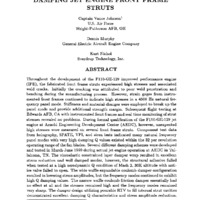-
Title
-
Damping Jet Engine Front Frame Struts
-
Description
-
Throughout the development of the F110-GE-129 improved performance engine (IPE), the fabricated front frame struts experienced high stresses and associated weld cracks. Initially the cracking was attributed to poor weld penetration and benching during the manufacturing process. However, strain gages from instrumented front frames continued to indicate high stresses in a 4500 Hz natural frequency panel mode. Stiffeners and material changes were employed to break up the panel mode and provide additional strength margin. Subsequent flight testing at Edwards AFB, CA with instrumented front frames and real time monitoring of strut stresses revealed no problems. During formal qualification of the F110-GE-129 jet engine at Arnold Engineering Development Center (AEDC), however, unexpected high stresses were measured on several front frame struts. Component test data from holography, SPATE, VPI, and siren tests indicated many natural frequency panel modes with very high damping Q values existed within the 32 per revolution operating range of the fan blades. Several different damping schemes were developed and tested in March-June 1990 during actual jet engine operation at AEDC in Tullahoma, TN. The viscoelastic constrained layer damper wrap resulted in excellent stress reduction and well damped modes, however, the structural adhesive failed
when tested at a high aerodynamic Q condition of Mach 2, 30K altitude with anti-ice valve failed to open. The wide waffle expandable coulomb damper configuration resulted in lowering stress amplitudes, but the frequency modes continued to exhibit high Q damping values. The narrow waffle coulomb friction damper essentially had no effect at all and the stresses remained high and the frequency modes remained very sharp. The damper design utilizing pourable RTV to fill internal strut cavities demonstrated excellent damping Q characteristics and stress amplitude reduction. Other damping designs were developed but not tested during engine test cell operation. The RTV damper method was chosen as the final design after qualifying at all F-16 fighter aircraft flight envelop operating conditions and further component tests to evaluate thermal and adhesion properties. In conclusion: "A little bit of damping goes a long way."
-
Creator
-
Johnson, Vance
-
Murphy, Dennis
-
Nichol, Kurt
-
Publisher
-
Wright-Patterson Air Force Base, OH :Wright Laboratory, Flight Dynamics Directorate, Air Force Systems Command
-
Date
-
1991
-
Format
-
1 online resource (2 pages)
-
Type
-
article
-
Abstract
-
Throughout the development of the F110-GE-129 improved performance engine (IPE), the fabricated front frame struts experienced high stresses and associated weld cracks. Initially the cracking was attributed to poor weld penetration and benching during the manufacturing process. However, strain gages from instrumented front frames continued to indicate high stresses in a 4500 Hz natural frequency panel mode. Stiffeners and material changes were employed to break up the panel mode and provide additional strength margin. Subsequent flight testing at Edwards AFB, CA with instrumented front frames and real time monitoring of strut stresses revealed no problems. During formal qualification of the F110-GE-129 jet engine at Arnold Engineering Development Center (AEDC), however, unexpected high stresses were measured on several front frame struts. Component test data from holography, SPATE, VPI, and siren tests indicated many natural frequency panel modes with very high damping Q values existed within the 32 per revolution operating range of the fan blades. Several different damping schemes were developed and tested in March-June 1990 during actual jet engine operation at AEDC in Tullahoma, TN. The viscoelastic constrained layer damper wrap resulted in excellent stress reduction and well damped modes, however, the structural adhesive failed
when tested at a high aerodynamic Q condition of Mach 2, 30K altitude with anti-ice valve failed to open. The wide waffle expandable coulomb damper configuration resulted in lowering stress amplitudes, but the frequency modes continued to exhibit high Q damping values. The narrow waffle coulomb friction damper essentially had no effect at all and the stresses remained high and the frequency modes remained very sharp. The damper design utilizing pourable RTV to fill internal strut cavities demonstrated excellent damping Q characteristics and stress amplitude reduction. Other damping designs were developed but not tested during engine test cell operation. The RTV damper method was chosen as the final design after qualifying at all F-16 fighter aircraft flight envelop operating conditions and further component tests to evaluate thermal and adhesion properties. In conclusion: "A little bit of damping goes a long way."
-
Date Issued
-
1991-08
-
Extent
-
2
-
Corporate Author
-
General Electric Aircraft Engine Company
-
Sverdrup Technology, Inc.
-
Laboratory
-
Wright Laboratory
-
Report Number
-
WL-TR-91-3078 Volume II, pages EDD-1 to EDD-2
-
DoD Project
-
2401
-
DoD Task
-
240104
-
Distribution Conflict
-
No
-
Index Abstract
-
Contrails only
-
Photo Quality
-
Not Needed
-
Distribution Classification
-
1
-
Report Availability
-
Full text available
-
Provenance
-
University of Colorado Colorado Springs, Kraemer Family Library
-
Identifier
-
ADA241312
